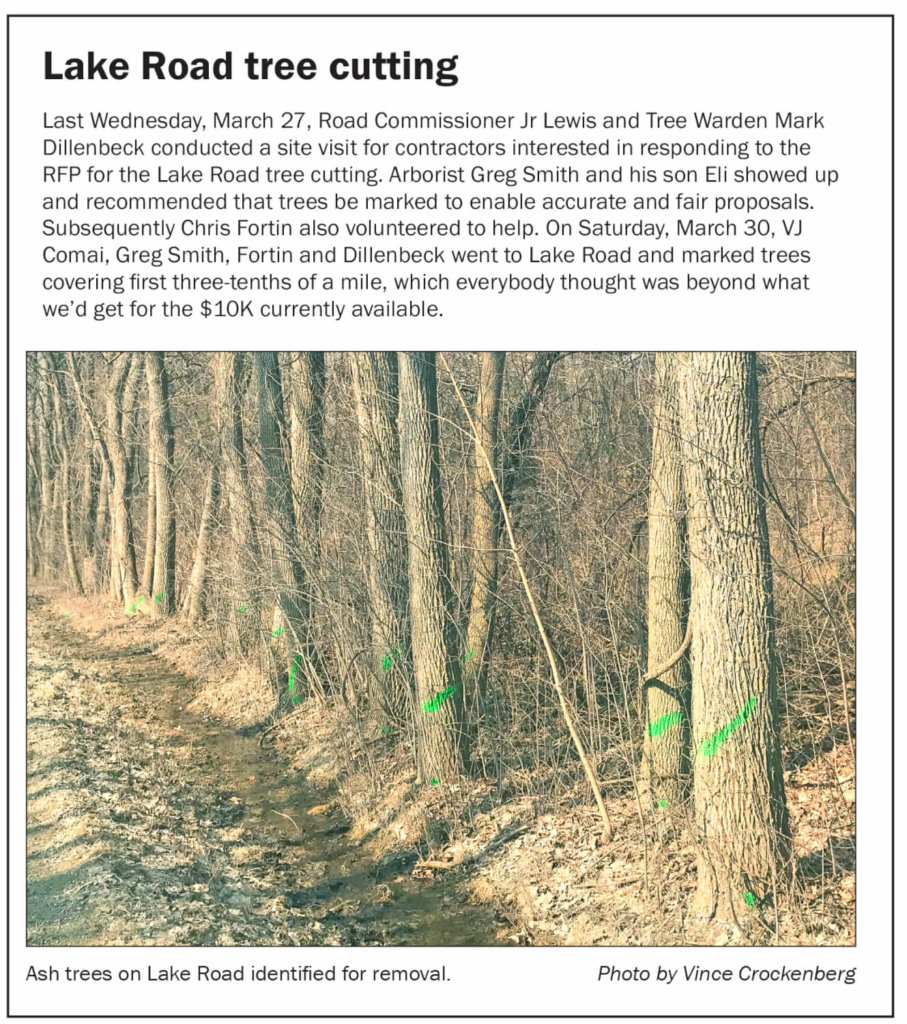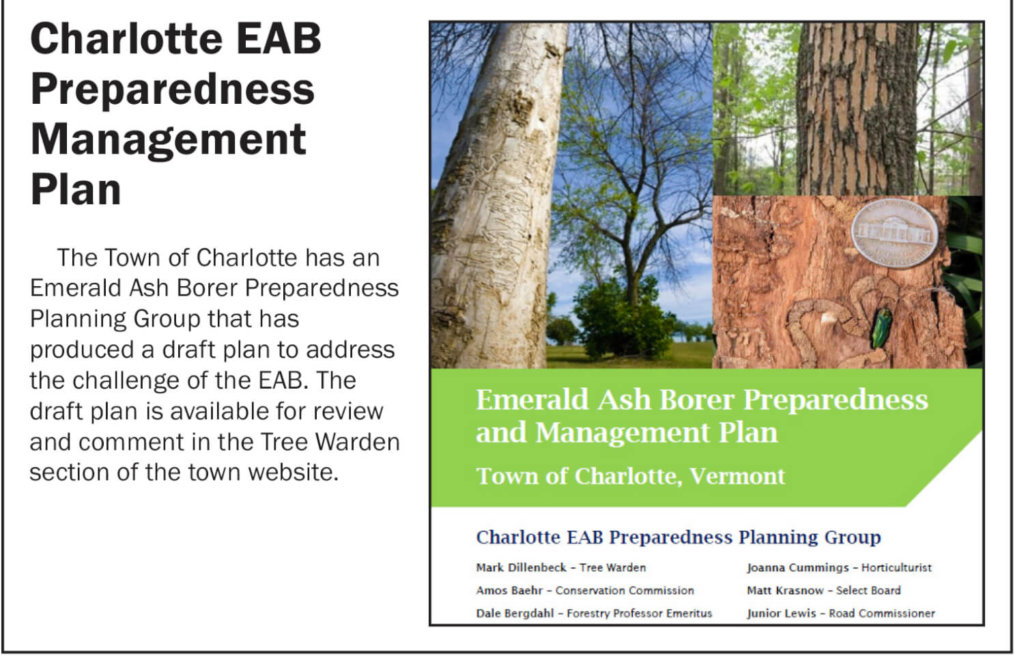Charlotte’s proactive response to the emerald ash borer problem
 Foresters, homeowners, local leaders and environmentalists have few choices when confronting the emerald ash borer (EAB). The damage wrought by this exotic beetle, first detected in Michigan in 2002, is devastating. Ash trees throughout North America are now formally classified as critically endangered and may become extinct in the wild during our lifetimes. Many millions have already died in areas where EAB has taken hold.
Foresters, homeowners, local leaders and environmentalists have few choices when confronting the emerald ash borer (EAB). The damage wrought by this exotic beetle, first detected in Michigan in 2002, is devastating. Ash trees throughout North America are now formally classified as critically endangered and may become extinct in the wild during our lifetimes. Many millions have already died in areas where EAB has taken hold.
Our Vermont State Forest Health Program manager, Barbara Schultz, estimates that we can expect ash tree mortality of 99.7%. This is the tragic reality for which we Charlotters need to prepare. As our ash trees follow the fate of the American chestnut, elm and butternut, we need to take practical measures to ensure public safety, maintain unobstructed roadways, and preserve the beauty of our landscape. Importantly, we need to accomplish these objectives in a manner that minimizes the burden to taxpayers.
Faced with the grim realities of certain emerald ash borer infestation, we recognize there is no “do- nothing” option. Instead we are developing an informed, proactive plan that weighs our community’s limited choices, taking into account safety, cost and aesthetics.
With regard to ash trees in public spaces and along our roadsides, we could wait until they start to succumb to EAB and deal with the problem at that point. The principal advantage of this approach is that it would allow us to postpone the expense and effort of removing ash trees for the maximum amount of time. There are problems with this reactive approach, however. The EAB infestation, once it arrives, will run its course quickly, leaving us to deal with a great number of dying or dead ash trees in a short period of time, perhaps two to three years. Our road commissioner could anticipate an unusually large number of emergency calls to remove fallen trees. These calls would happen at random times and at random points and would require repeat visits by crews to the same areas. That would be an expensive way to operate.
 Another problem has to do with the physical structure of ash trees themselves. Dead ash trees in general—and EAB-killed ash trees in particular—tend to crumble and are prone to catastrophic failure. They present a particular hazard to chainsaw operators and can be difficult and dangerous to fell compared to other kinds of trees. This can make removing a dead ash tree significantly more expensive than removing a live one.
Another problem has to do with the physical structure of ash trees themselves. Dead ash trees in general—and EAB-killed ash trees in particular—tend to crumble and are prone to catastrophic failure. They present a particular hazard to chainsaw operators and can be difficult and dangerous to fell compared to other kinds of trees. This can make removing a dead ash tree significantly more expensive than removing a live one.
These considerations have led us to develop a proactive approach being adopted by other towns and cities threatened by EAB. The first element is to choose some trees to preserve with chemical treatments. We have identified seven ash trees on town property that we want to conserve in this manner. We are also encouraging landowners to consider chemical treatment of select ash trees on their properties. These treatments, however, are expensive, typically $150 to $400 per tree, and need to be repeated every two years in perpetuity. It is not a viable solution for most trees in the public right of way.
The second element is to begin now to remove currently live but doomed ash trees. This option has several advantages. It will enable the town to space out the costs of tree removals over a longer period of time. In addition, by removing most trees while they are still alive we will avoid the additional expense and danger of dead ash tree removals. Finally, by removing all potentially hazardous ash trees along a section of roadway, we will be able to operate more efficiently and therefore at less expense. Our enjoyment of roadways free of the sight of an unusually large number of dead and dying trees is an important secondary benefit.
 Lake Road from Thompson’s Point Road to Ferry Road will be a test case. We chose this section of road because it has one of the highest concentrations of ash trees in Charlotte. Sometime between now and the end of June crews will come to fell these trees. The crews will chip the tree tops, and the chips will be given to nearby landowners. The logs will be left by the roadside and will be available to the respective landowners to use for firewood if they choose. While authority to remove potential hazard trees in the right-of-way resides with the town, the wood belongs to the landowners. Any unclaimed wood will be moved by the road commissioner’s crew to the site of the old flea market on Route 7 where it will be available upon request (details to be worked out with Town Administrator Dean Bloch) to residents for noncommercial purposes.
Lake Road from Thompson’s Point Road to Ferry Road will be a test case. We chose this section of road because it has one of the highest concentrations of ash trees in Charlotte. Sometime between now and the end of June crews will come to fell these trees. The crews will chip the tree tops, and the chips will be given to nearby landowners. The logs will be left by the roadside and will be available to the respective landowners to use for firewood if they choose. While authority to remove potential hazard trees in the right-of-way resides with the town, the wood belongs to the landowners. Any unclaimed wood will be moved by the road commissioner’s crew to the site of the old flea market on Route 7 where it will be available upon request (details to be worked out with Town Administrator Dean Bloch) to residents for noncommercial purposes.
Lessons learned from the Lake Road test case will be applied to the rest of Charlotte. The current proactive approach is not set in stone, and the Charlotte EAB Preparedness Plan Group (see insert) is open to suggestions and feedback. Thank you in advance for your support of our efforts to address the EAB challenge in an informed, cost-effective and safety-conscious manner.

